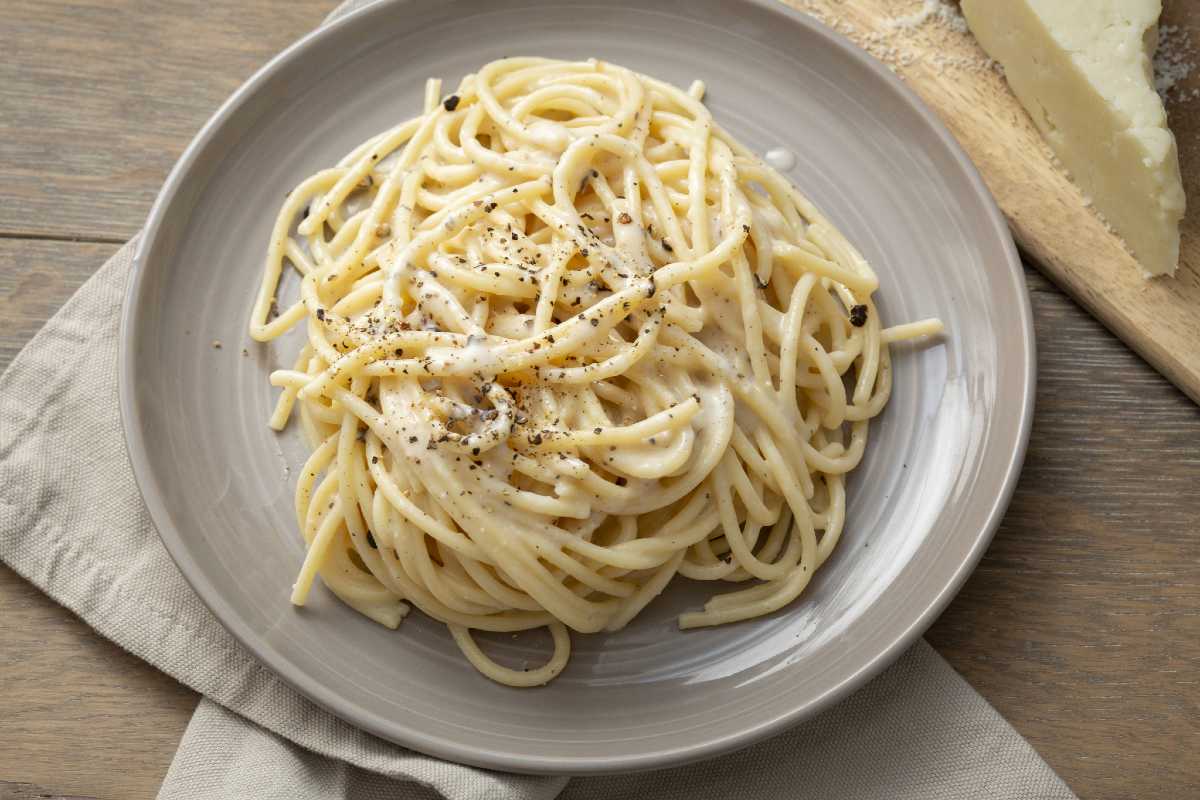Pasta allo scarpariello
- Very easy
- 20 min
- Kcal 221


Creamy, peppery flavor makes this easy cacio e pepe recipe a real family favorite at dinner time. Simple beauty describes a bowl of spaghetti cacio e pepe—twirls of pasta covered in just the right amount of Pecorino Romano cheese and fresh black pepper, with a nice, soft creaminess that always looks so inviting on the plate. The way the sauce brings together that unmistakable bite of aged Italian cheese with the bold kick of cracked pepper makes this dish stand out...it’s exactly what you’d expect from a traditional Roman pasta so loved in homes everywhere. For everything from regular Sunday suppers to more special get-togethers, this authentic Italian pasta looks great served family-style in a big bowl—kids usually smile right away when they spot those glossy, cheesy noodles! For home cooks who want tasty results but appreciate reliability, this classic cacio e pepe gives that fluffy, great texture without any fuss—plus the cheesy, savory aroma filling the kitchen just feels welcoming and DELICIOUS every time.
Busy weeknights get a lot easier with this family-friendly cacio e pepe recipe—no advanced skills needed here, just pure, dependable enjoyment. Versatility is pretty nice—you can serve this pecorino pasta as a complete main dish or as an easy side at bigger gatherings (works REALLY well both ways). Since the creamy cheese sauce coats every strand so well, it’s easy to pair it up with things kids and adults actually like...maybe roast veggies, a green salad, or just some garlic bread if you want a little extra comfort. Even picky eaters appreciate the simple, rich taste and nice bite, while adventurous families might add lemon zest, more fresh pepper, or sprinkle herbs for variety. For home bakers who want something guaranteed to please but not boring, this spaghetti cacio e pepe delivers every time—a truly good, home-run meal that’s always welcome around the table. Kids can’t get enough, adults love the cheesy depth, and everyone ends up full and happy...that’s the magic of classic black pepper spaghetti done right.
You might also like:

To prepare spaghetti cacio e pepe, first of all grate the Pecorino cheese. Continue boiling some water in a pan (use about half of what you usually use to cook pasta, so it will be richer in starch) and when it boils you can add salt to taste. Once salted, you can cook the spaghetti 1. In the meantime, pour the whole peppercorns on a cutting board 2, then crush them with a meat pestle or a grinder 3. This will release more of the pungent scent of the pepper.

Pour half of the crushed pepper into a large non-stick pan 4, toast over low heat stirring with a wooden spoon, then add a couple of ladles of cooking water 5. The bubbles you see appearing are from the starch contained in the water. Drain the spaghetti when it is very al dente (keeping the cooking water aside to use later) and pour the pasta directly into the pan with toasted pepper 6; it will continue cooking with the seasoning.

Stir the pasta continuously with the kitchen tongs to make it “breathe" 7 and add a ladle of water or two if necessary, to continue cooking 8. Keep pouring a ladle of water only when needed (when you see that the pan is almost completely dry) and stir with kitchen tongs. In the meantime, when the pasta is ready, prepare the Pecorino cream (don't start this operation before because the cream would get too thick): pour about half of the grated Pecorino cheese into a bowl 9.

Add a ladle of cooking water to the grated Pecorino cheese 10. Stir vigorously with a whisk 11 and add more water when needed. Then add the remaining half of the Pecorino cheese, keeping a little bit aside to garnish later 12. Add a little more water if needed: at this stage you will have to carefully adjust the amount of Pecorino cheese to the water to obtain a cream of the right consistency and without lumps.

Finish cooking your pasta, adding a little more hot water if necessary; before adding the Pecorino cream, briefly stir the cream by placing the bowl over the steam of the pan with hot water, always stir with the whisk 13, so as to bring the cream back to a temperature similar to the one of your pasta if necessary 14. Turn the heat off under the pan with spaghetti and pour in the Pecorino cream 15.

While pouring the Pecorino cream onto your spaghetti, stir it continuously with the kitchen tongs 16, pour the Pecorino you kept aside in too 17, stir and sauté the pasta again, then transfer your spaghetti cacio e pepe to a plate and season with the remaining pepper, enjoy immediately in all its creaminess 18!